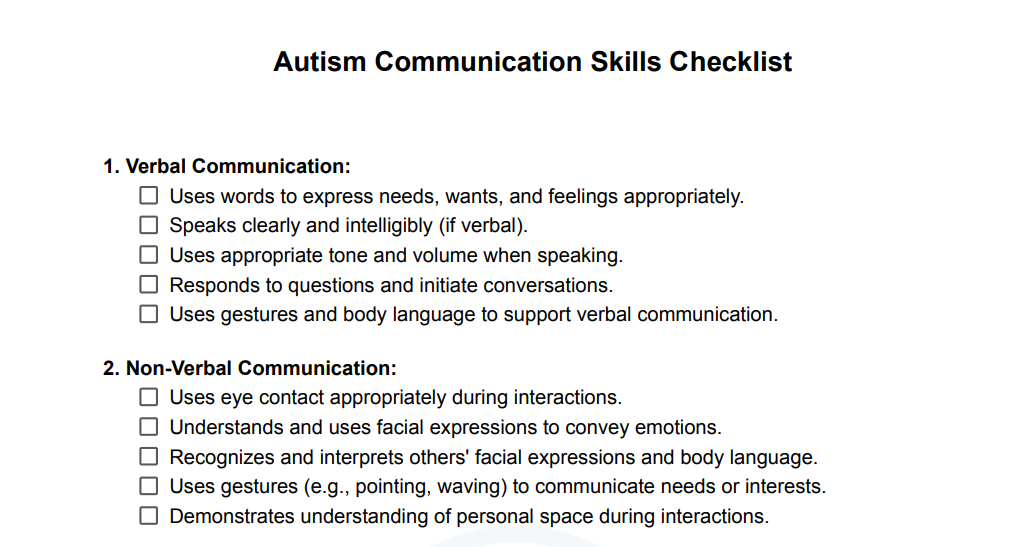Autism Communication Skills Checklist is designed to provide a structured framework for assessing various aspects of communication in individuals with autism. It covers verbal, nonverbal, social, and functional communication skills, offering a holistic view of an individual’s communication abilities.

Download Your FREE Autism Communication Skills Checklist PDF Now
Download your FREE PDF resource of Autism Communication Skills Checklist.
Step-by-Step Guide to Using the Checklist
- Gather Information: Begin by gathering relevant information about the individual, including their age, developmental history, current communication methods, and any specific communication challenges they may face.
- Observation and Assessment: Observe the individual in different communication contexts, such as social interactions, daily routines, and structured activities. Use the checklist to assess their communication skills across the designated areas.
- Verbal Communication: Evaluate their verbal communication skills, including pronunciation, vocabulary usage, conversational abilities, and understanding of figurative language. Note any strengths or areas that may require additional support.
- Nonverbal Communication: Assess nonverbal communication cues such as eye contact, body language, gestures, and use of visual supports. Pay attention to how they express emotions, preferences, and needs through nonverbal means.
- Social Communication: Observe their social communication skills, including understanding social cues, taking turns in conversations, recognizing emotions in others, and engaging in reciprocal communication. Identify areas where they may benefit from social skills training or support.
- Functional Communication: Evaluate their ability to express basic needs and wants effectively, such as asking for assistance, requesting items, and communicating preferences. Consider the use of alternative communication methods, such as visual aids or AAC devices, if needed.
- Collaborative Planning: Based on the assessment results, collaborate with caregivers, educators, therapists, and other professionals involved in the individual’s support network. Develop personalized communication goals and strategies to address identified areas of improvement.
- Implementation and Support: Implement the communication goals and strategies in daily interactions and activities. Provide ongoing support, feedback, and encouragement to reinforce positive communication behaviors and address challenges as they arise.
- Monitor Progress: Regularly monitor and track the individual’s progress towards their communication goals. Adjust strategies as needed based on their evolving needs and strengths.
Benefits of Using the Checklist
- Comprehensive Assessment: The checklist offers a comprehensive assessment of communication skills, helping to identify strengths and areas for growth across multiple domains.
- Individualized Support: It enables the development of individualized communication goals and strategies tailored to the unique needs and preferences of each individual.
- Collaborative Approach: The checklist encourages collaboration among professionals, caregivers, and individuals with autism, fostering a supportive and inclusive communication environment.
- Progress Tracking: Monitoring progress over time, allows for adjustments and refinements to communication interventions, ensuring continuous improvement.
Conclusion
The Autism Communication Skills Checklist serves as a valuable tool for understanding, assessing, and enhancing communication skills in individuals with autism. By following a structured approach and collaborating with a supportive network, we can create meaningful opportunities for communication growth, connection, and empowerment. Together, let’s nurture and celebrate the diverse communication abilities within the autism community.








